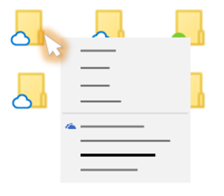OneDrive Files On-Demand helps you access all the files in your cloud storage in OneDrive without having to download them and use storage space on your computer.
Note: Starting with OneDrive build 23.066 Files On-Demand is enabled by default for all users.
With Files On-Demand, you’ll see all your files as online-only files in File Explorer, but they won't take up space. When you’re connected to the Internet, you’ll be able to use the files like every other file on your device.
You can also select files and folders to be always available, even if you're offline. OneDrive will download them, and they'll take up space on your PC.
With OneDrive Files On-Demand, you can:
-
Save space on your device by making files online only
-
Set files and folders to be always available locally on your device
-
See important information about files, such as whether they are shared
-
See thumbnails of over 300 different file types even if you don’t have the required application installed to open it
Your files will have these statuses in File Explorer:
|
|
A blue cloud icon next to a OneDrive file or folder indicates that the file is only available online. Online-only files don’t take up space on your computer. You see a cloud icon for each online-only file in File Explorer, but the file doesn’t download to your device until you open it. You can’t open online-only files when your device isn’t connected to the Internet. |
|
|
When you open an online-only file, it downloads to your device and becomes a locally available file. You can open a locally available file anytime, even without Internet access. If you need more space, you can change the file back to online only. Just right-click the file and select “Free up space.” With Storage Sense turned on, these files will become online-only files after the time period you've selected. |
|
|
Only files that you mark as "Always keep on this device" have the green circle with the white check mark. These always available files download to your device and take up space, but they’re always there for you even when you’re offline. |
If Files On-Demand is not enabled, make sure you’re signed in to OneDrive on your device.
Open OneDrive settings (select the OneDrive cloud icon in your notification area, and then select the OneDrive Help and Settings icon then Settings.)
Go to the Sync and back up tab, expand the Advanced settings, and toggle on Files On-Demand
-
Right-click a file or folder.
-
Select Always keep on this device or Free up space.

Notes:
-
New files or folders created online or on another device appear as online-only to save maximum space. However, if you mark a folder as "Always keep on this device," new files in that folder download to your device as always available files.
-
If a folder is online-only, you can still mark individual files within that folder as always available.
-
Desktop search can search for online-only files by name, but it cannot search the contents within online-only files because they aren't stored on the device.
Frequently asked questions
Files On-Demand requires version Windows 10 1709 or later, or Windows Server 2019
OneDrive build 23.066 or later has Files On-Demand enabled by default.
Files On-Demand might not be compatible with some third-party antivirus solutions.
Files On-Demand is not yet supported when WIP is enabled.
Files On-Demand works with all your personal and work files from OneDrive, SharePoint in Microsoft 365, and SharePoint Server 2019 team sites.
Yes, you can move online-only files within your OneDrive folder for that OneDrive account. When you move files outside that OneDrive folder, the files download to the new folder and are removed from your OneDrive.
With your files and folders in the OneDrive cloud backup, if you accidentally delete something, you can restore them from your OneDrive recycle bin.
When you delete an online-only file from your device, you delete it from your OneDrive on all devices and online. You can restore deleted files and folders from your OneDrive recycle bin on the web for up to 30 days for items stored in OneDrive personal (when you're signed in with a Microsoft account), or for up to 93 days for items stored in OneDrive for work or school or SharePoint in Microsoft 365 (when you're signed in with a work or school account). If you delete a locally available file, it also appears in your device recycle bin.
If you want to hide a folder on your device, see Choose a folder to hide on your device.
No, changing a file to online-only doesn't delete it from your OneDrive. The file no longer takes up space on your device, and you will still be able to see the file from OneDrive mobile apps or on the website.
First, make sure you don't have Windows Information Protection (WIP), previously known as enterprise data protection (EDP) configured on your computer. Files On-Demand is not yet supported when WIP is enabled.
If you aren't seeing the Files On-Demand options, the latest version of OneDrive hasn't rolled out to you yet. Here's how to get the latest version of OneDrive.
-
Make sure you're running Windows 10 Fall Creators Update (version 16299.15 or later).
-
Download and install the latest version of OneDrive that's rolling out with the Windows 10 Fall Creators Update.
-
Restart your computer.
-
After your computer restarts, select the Start button, search for “OneDrive”, and then select the OneDrive desktop app.
-
When OneDrive Setup starts, enter your personal account, or your work or school account, and then select Sign in.
-
Follow the instructions to Turn on Files On-Demand.
We are updating the OneDrive sync app advanced settings for Files On-Demand for users who have the feature enabled.
The behavior change occurs for users who have Files On-Demand enabled. There is no change at this time for users that have the feature disabled from OneDrive settings or by admin policy.
After this change, users who have Files On-Demand enabled will see two buttons:
-
Free up disk space: This is the default and recommended behavior. New files from the cloud are online-only by default, not taking up disk space. Files are downloaded to the device if a user opens them or chooses the option to “Always keep on this device” from the context menu in File Explorer. Files created on the device are available offline by default.
-
Download all files: This setting is equivalent to choosing the option to “Always keep on this device” from the context menu in File Explorer for the entire OneDrive folder. Selecting this option causes all files from the cloud to be downloaded, taking up disk space on the device. The behavior of this setting is equivalent to the legacy option of turning off Files On-Demand mode, with some improvements like updated icons.
Learn more
-
To learn more about notifications when Windows automatically downloads online-only files for your apps, see Automatic file download notifications in Windows 10.
Need more help?
|
|
Contact Support
For technical support, go to Contact Microsoft Support, enter your problem and select Get Help. If you still need help, select Contact Support to be routed to the best support option. |
|
|
|
Admins
|
Tip: IT Admin should read OneDrive Files On-Demand for Enterprise.















